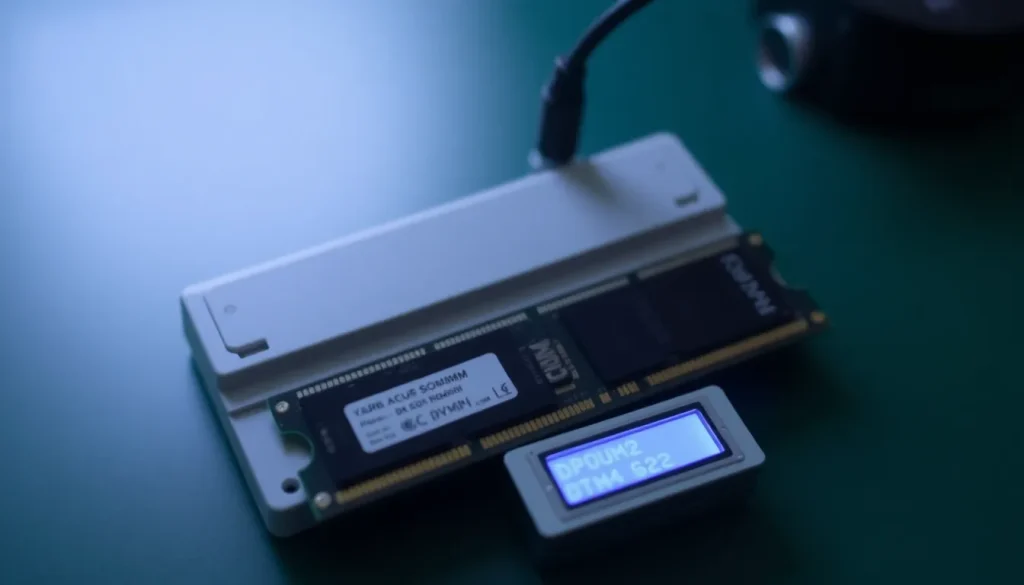Russian Tech Service Develops DDR5 SODIMM Memory Tester with LED Display

In the rapidly evolving world of technology, the tools used for diagnostics and repairs also need to keep pace with advancements. As the transition from older memory standards to DDR5 takes place, a Russian technician has developed an innovative device that could revolutionize the industry of laptop repairs. This device, a DDR5 SODIMM memory tester, not only addresses the essential voltages and data signals but also incorporates features aimed at significantly reducing the time spent troubleshooting complex issues.
Innovative DDR5 SODIMM memory tester designed for technicians
The landscape of memory testing has shifted dramatically from the days when DDR3 and DDR4 testers were commonplace. Today, the spotlight is firmly on DDR5, especially for devices employing SODIMM modules commonly found in laptops. This newly developed memory tester stands out in its ability to directly access the SPD information, which is critical for any technician involved in laptop repairs.
By accessing the Serial Presence Detect (SPD) data, the technician can see crucial parameters and addresses, such as frequencies and timings. This feature allows for quick checks on whether communication exists in that area, enabling a more accurate diagnosis of the laptop issues at hand. In practice, this means technicians can effectively eliminate false leads and pinpoint problems more efficiently.
A notable feature of this memory tester is its ability to display the last five POST codes on a small LED screen. However, this functionality is dependent on the motherboard supporting it, and is currently available in select ASUS laptop models with Quanto boards. This feature provides technicians with instantaneous feedback on the device's status, making the troubleshooting process smoother.
Redesigning for efficiency
The evolution of this DDR5 tester involved significant redesign work compared to its predecessors. One major change was the removal of the space for inserting flash chips into the RAM, a feature that was seldom used, according to the developer. This allowed for the integration of a more comprehensive circuitry and the addition of a PMIC chip, which enhances the device's ability to efficiently manage power.
This upgrade not only improves the tester’s performance but also expands its diagnostic capabilities, making it a valuable tool for technicians who deal with DDR5 memory. By focusing on the needs of modern laptops, the designer has created a device that meets current demands while paving the way for future innovations in memory testing.
Limitations to consider
While the new DDR5 SODIMM memory tester boasts impressive features, there are certain limitations worth noting. A key point of compatibility is related to laptops with AMD processors since DDR4. Each RAM slot in these laptops has its own reset mechanism, meaning the tester may not visibly indicate these signals. This aspect can lead to confusion during diagnostics, particularly for those who are more familiar with Intel systems, where a common reset is shared across all slots.
The emergence of this new tester also marks the end of production for tools designed for DDR3 and DDR4. The rationale is straightforward: demand for these older models has diminished significantly, given that there are already sufficient alternatives available in the market. As DDR5 continues to dominate, the industry will focus its efforts and sales strategies around this new standard.
Impact on the repair industry
Tools like this DDR5 memory tester illustrate how technological transitions impact the repair industry. Although the segment might seem niche, the differences in diagnostic speed can be critical. Fast and accurate diagnosis can be the difference between a prolonged repair process and a quick resolution, ultimately affecting customer satisfaction and business efficiency.
As this device was developed by a technician working in a repair shop, it stands as a testament to the real-world needs and challenges faced by professionals in the field. The insights gained from practical experience have informed the design and functionality of this tester, ensuring it meets the specific requirements of laptop repairs.
Future considerations for memory testing tools
As technology continues to evolve, the demand for even more advanced diagnostic tools will likely grow. Future iterations of memory testers may incorporate features such as:
- Enhanced compatibility with a broader range of laptop models
- Integration of software solutions for real-time diagnostics
- Multi-functionality for testing other components like CPUs and GPUs
- Wireless connectivity for easier data reporting and updates
These advancements could further streamline the repair process, allowing technicians to offer quicker and more reliable service. The focus will continue to shift towards tools that not only identify issues but also provide actionable insights for effective repairs.
The potential for mass production
The creator of the DDR5 SODIMM memory tester has expressed intentions to potentially commercialize the device. If this product becomes widely available, it could fill a significant gap in the market for laptop repair tools. The demand for such a specialized device indicates a growing recognition of the challenges faced by technicians in the modern tech landscape.
With the right marketing and distribution strategies, this tester could emerge as a go-to tool for professionals handling DDR5 SODIMM modules. Its combination of practicality, efficiency, and the technician's firsthand experience in its design could resonate well within the industry.
In conclusion, the development of the DDR5 SODIMM memory tester represents a significant step forward in memory diagnostics. By addressing current needs while anticipating future trends, this tool has the potential to become indispensable for technicians in the evolving world of laptop repairs.




Leave a Reply